We ll Be Together Again Jazz Guitar Lesson

The first fourth dimension I was handed a jazz chord chart, I was 13 years old and trying to prove to the director of my middle-school jazz band that I could cutting information technology as the ensemble'due south guitarist. I had been on his bad side always since I nearly flunked out of his symphonic band as an alto saxophonist, then when I requested an audition, he practically laughed me out of the room.
Nevertheless, he handed me a chord chart - also referred to as a "lead sheet" - and told me to bring my A-game to the audience.
To cut a long story brusk, I bombed the audition, non because I couldn't play but because I had no understanding of how to properly approach the textile. Instead of following the changes given to me, which were all standard 7th chords, I played triadic major and minor chords, which are in most cases stylistically inappropriate for jazz.
Comping is the jazz idiom's stylized term for chordal and rhythmic accompaniment, and there are as many approaches to comping every bit at that place are approaches to jazz itself
The director asked me to play "Freddie Green–style," and I merely shrugged and wondered silently who Freddie Green was. After my embarrassing performance, I knew I needed to buckle downwards and study jazz rhythm guitar if I wanted to be a part of that scene.
While the audition gave me a good idea of where to offset, I had no idea just how deep the rabbit hole would go. That experience inspired this month's lesson: a guide to jazz guitar comping styles.
Compingis the jazz idiom's stylized term for chordal and rhythmic accompaniment, and there are as many approaches to comping as at that place are approaches to jazz itself.
In this lesson, we'll explore the many considerations you need to take when choosing your approach, which inevitably boils down to ane question: "How practise I best support the melody or the soloist?"
Choosing Your Rhythm
Rhythm is one of the most important tools in your comping tool kit. The correct rhythmic accompaniment can make your band or the soloist shine, whereas the wrong ane tin can make everything feel stilted and off residue.
In this section, our examples will follow the mutual jazz chord progression ii - 5 - I - half dozen in the cardinal of Bb (Cm7 - F7 - Bbmaj7 - Gm7). Allow'south use information technology to intermission down some of the most common jazz guitar rhythms.
Freddie Green way:Freddie Green was the definitive and well-nigh influential jazz rhythm guitarist of the early 20th century. Over Light-green's 50-year tenure with the Count Basie Orchestra, his style became divers by 7th chords played in a staccato, quarter-note rhythm, which came to be known as a "flat-iv feel," as demonstrated inEx. one.
Example one
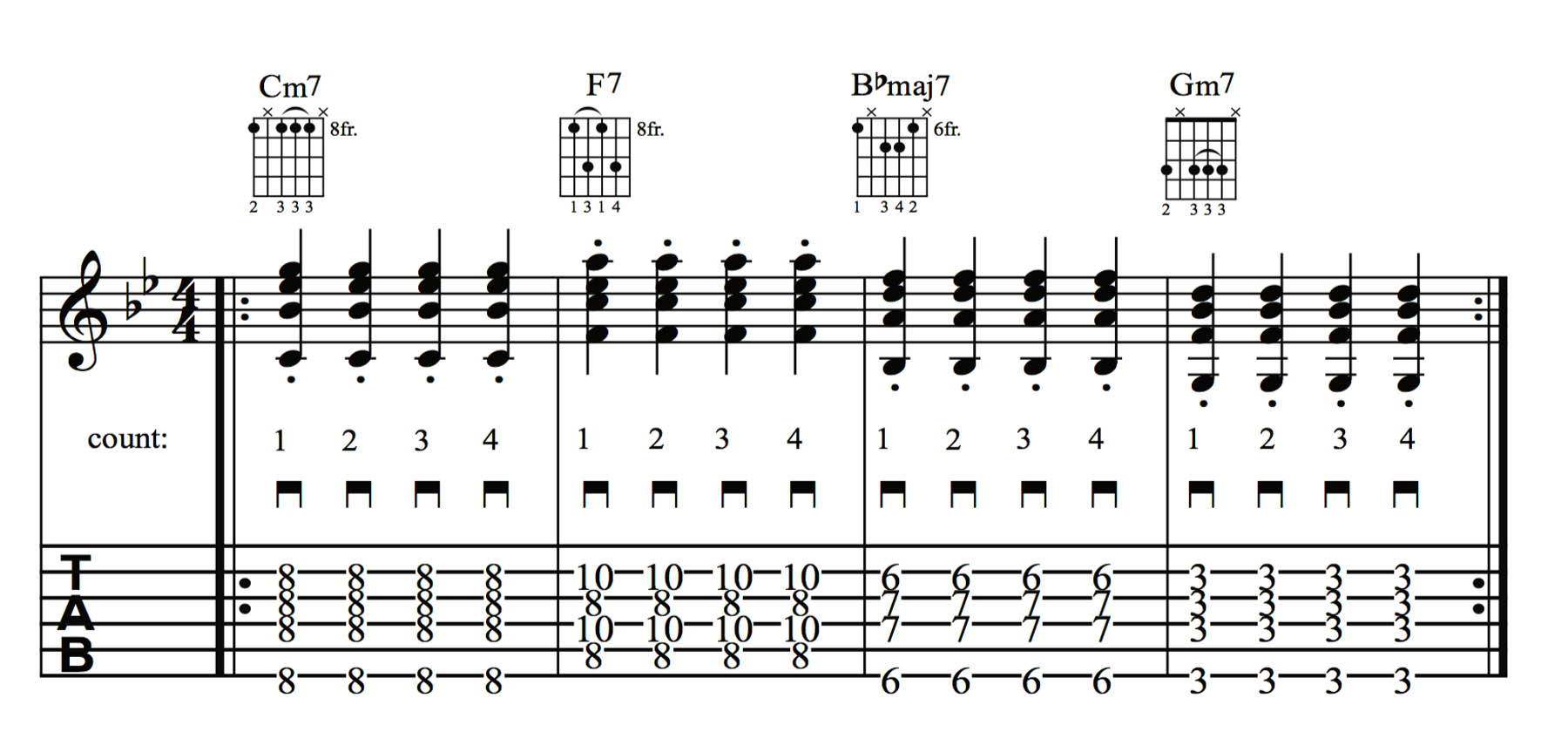
Two and Four:A more than sparse approach to Freddie Green style, this rhythmic pattern encompasses playing quarter notes on beats 2 and 4 only, with rests on beats 1 and 3, equally inEx. 2a. Think of this approach as matching the typical backbeat snare drum hits heard in a rock, blues, state or R&B groove.
When playing this example and all those that follow, exist sure to completely silence the strings during the rests and also right subsequently playing a chord with a staccato articulation (indicated past a small black dot appearing directly above or beneath a note head).
This is efficiently done with any fretted note or chord shape past loosening or relaxing your fret hand'due south grip on the strings, so that they break contact with the frets, but without actually letting go of the strings, every bit doing so could crusade them to ring open up.
Example 2a
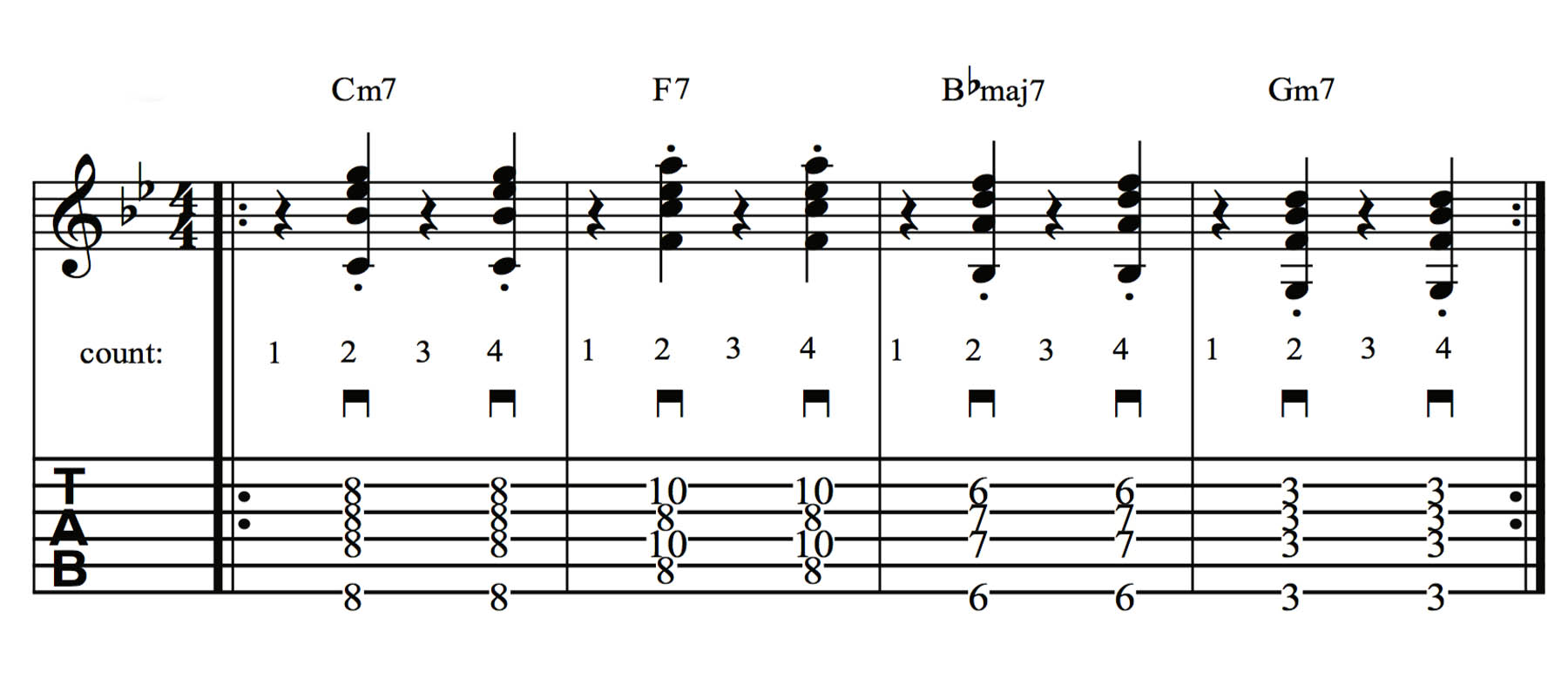
A more rhythmically complex variation on this blueprint incorporatessyncopation. This entails accentuating the "weak" parts of the beat out, meaning any subdivision that falls between the beats, and playing 1 or both of these hits on the following 8th-note upbeat, which would exist on the "and" count instead of the downbeat, as shown inEx. 2b.
Be sure to tap your pes squarely on each beat as you lot play and to observe the helpful counting prompts that are included here every bit a guide.
Example 2b
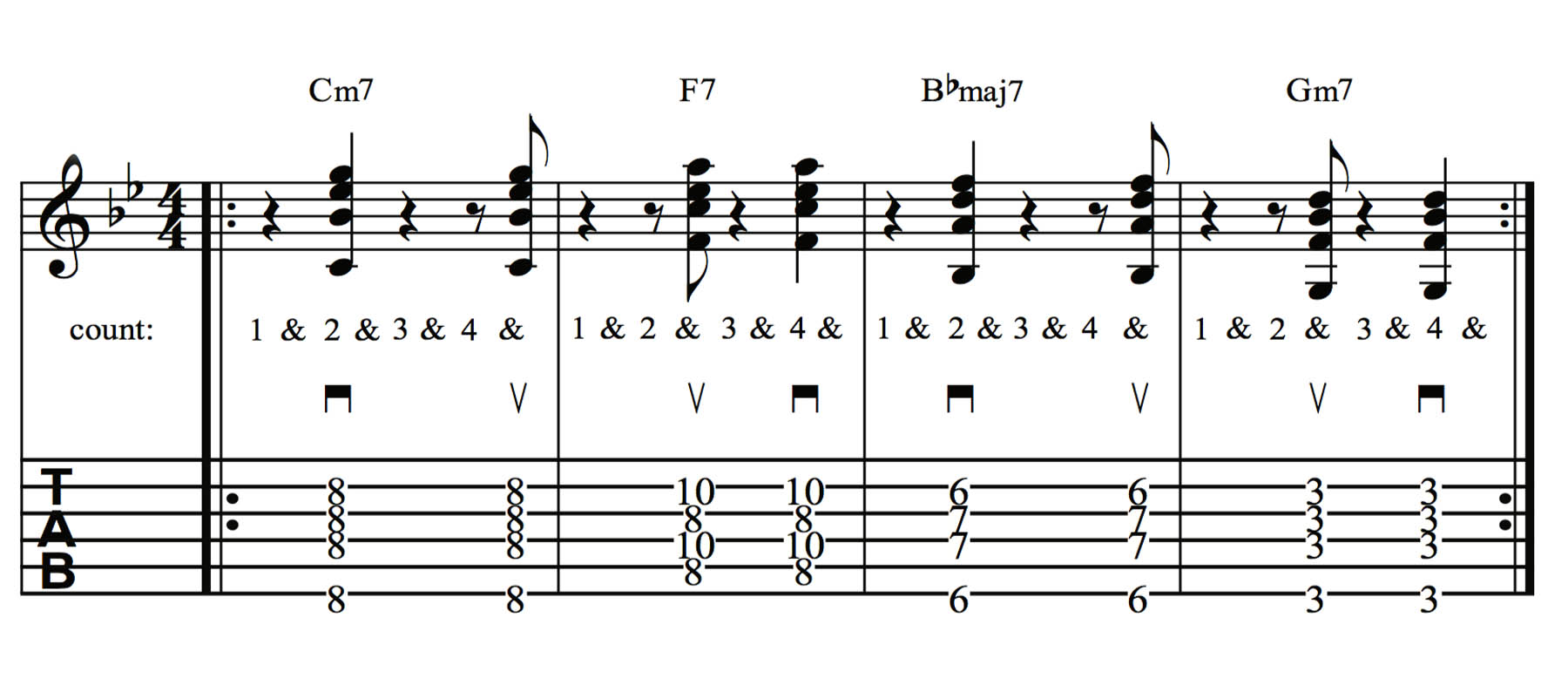
Charleston Rhythm:The Charleston Rhythm first originated with the Charleston trip the light fantastic popularized in the 1920s and consists of a dotted quarter note followed by an eighth note.
Ex. 3adepicts the bones version of the blueprint, with a dotted quarter note on trounce i and an eighth note falling on the "and" of beat ii ("oneand 2and3 and 4 and"), followed by a rest on beats 3 and iv.
Instance 3a

Ex. 3bis a variation on the Charleston rhythm, in which the pattern is displaced a half a crush frontward, with the dotted quarter note at present falling on the "and" of beat out 1 and the eighth annotation falling squarely on beat 3.
Instance 3b
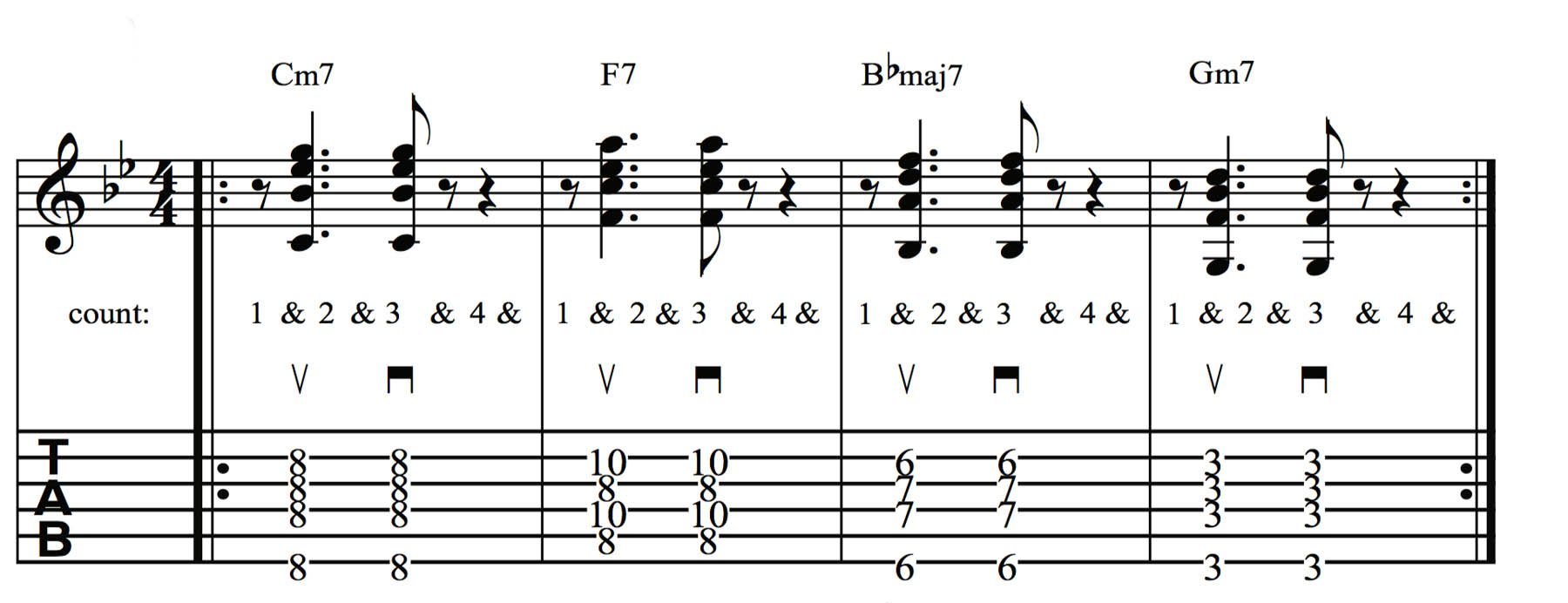
Ex. 3calternates betwixt both of these rhythms to create more variation, interest and motion through the chord progression.
Example 3c
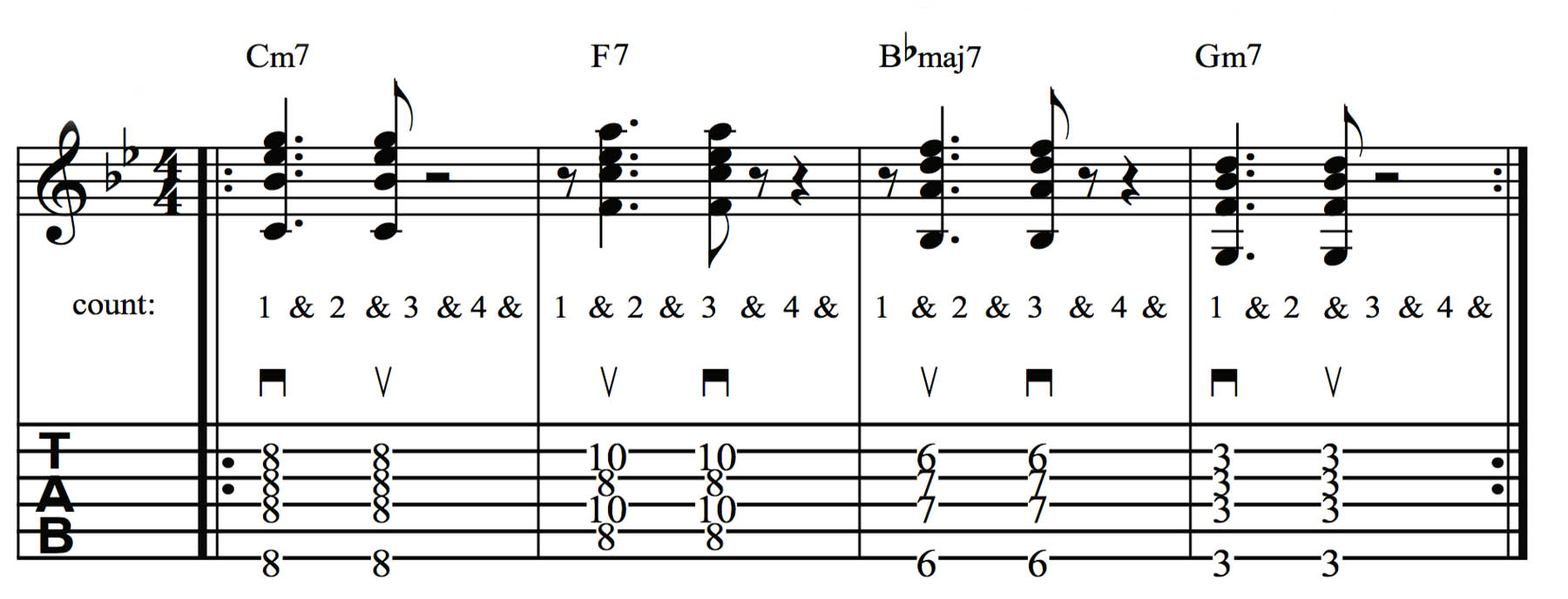
Clave:Common to each of the many varieties of Latin and Afro-Cuban jazz, the clave is a rhythmic blueprint of eighth notes based around five accented hits, alternating on and off the vanquish and spread out over either one or two measures, or bars.
While there are a number of approaches to the clave, the virtually common is theson clave, which consists of 1 bar with three accents, followed by another bar with ii accents. These rhythmic groupings can be arranged as "3-2" or "2-3." When spread across two confined, the three hits come in on beat i, the "and" of beat 2, and on beat 4 in the first bar, followed in the next bar past two hits, on beats ii and iii.
This is demonstrated inEx. 4a, with the iii-2 son clave, andEx. 4bshows the popular 2-3 variation. If this rhythmic motif sounds familiar, it's considering the 3-2 son clave is as well known as the "Bo Diddley beat," one of the most iconic rhythms in rock and pop music.
One time y'all have these rhythms down, effort combining them. The key is to complement the song and the melody instrument and not overplay.
Example 4a
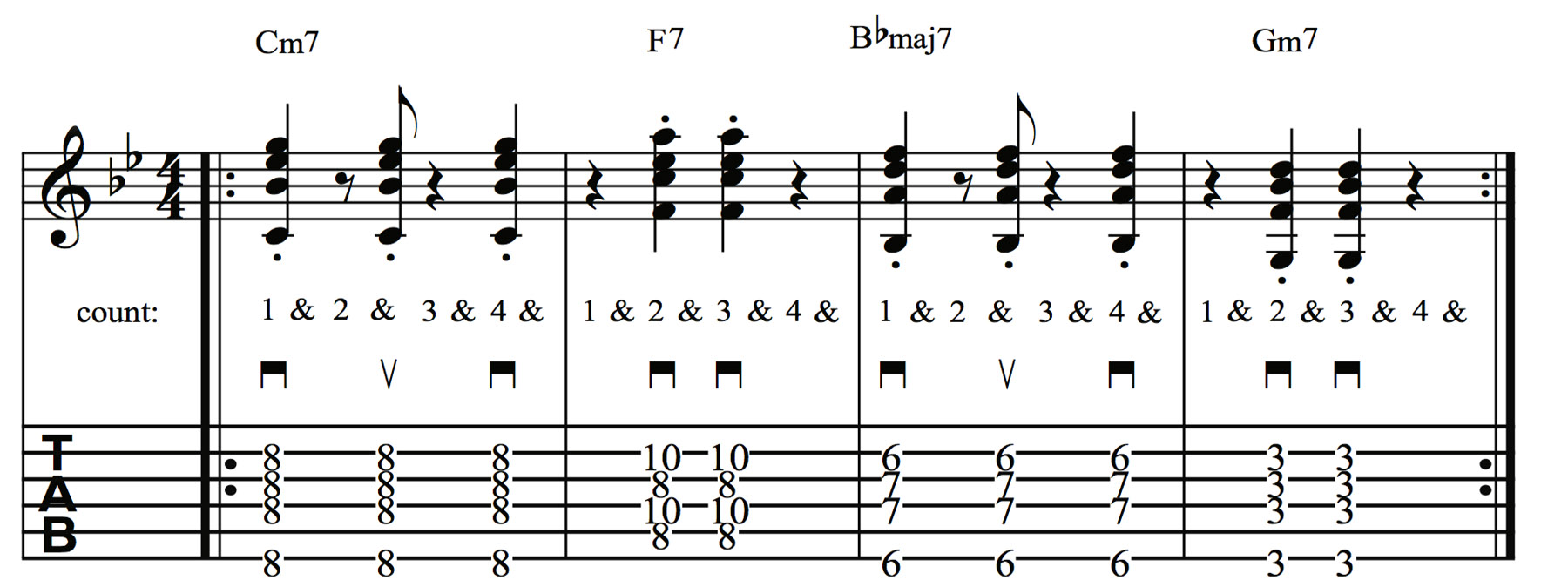
Example 4b
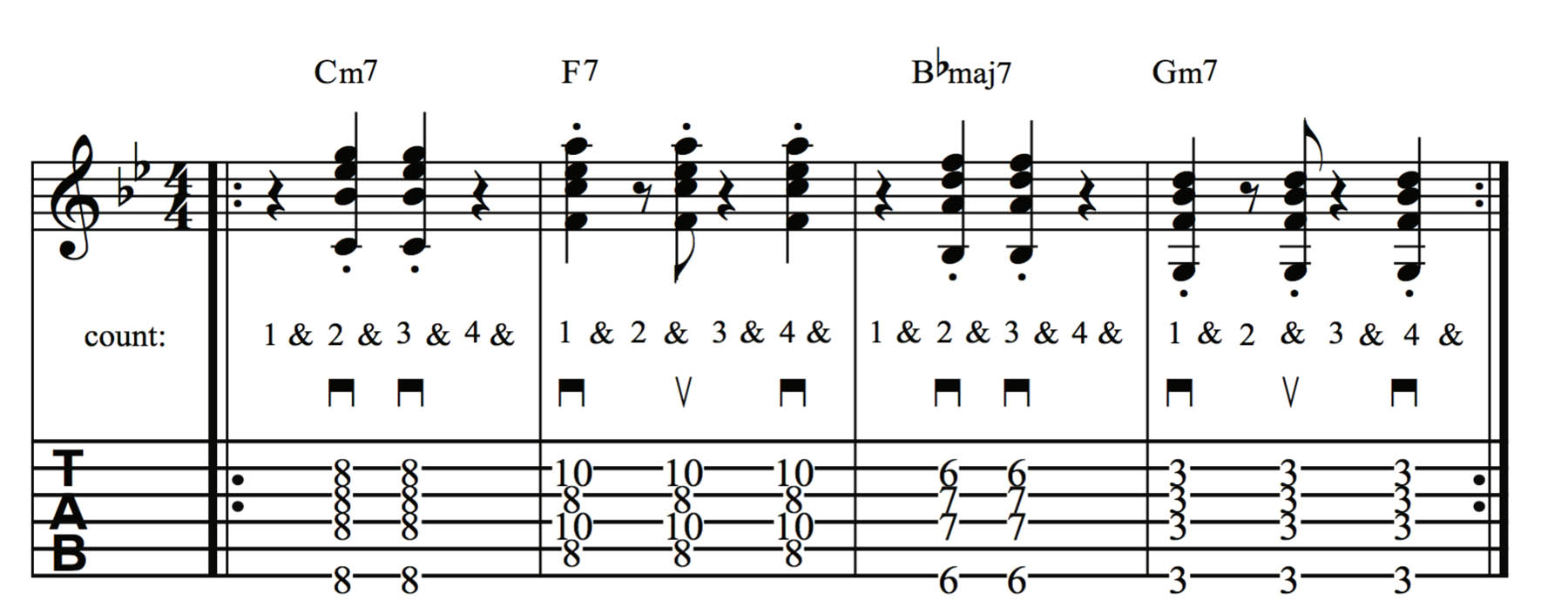
Choosing Chord Voicings
The harmonic language of jazz primarily involves the utilize ofseventh chords, which are 4-note entities consisting of a root, 3rd, 5th and 7th. In add-on to these chord tones you can utilisechord tensionsto add to the harmonic density and "bite" of a chord.
These tensions, which are 9ths, 11ths and 13ths, tin be found an octave above the second, 4th and 6th scale degrees above the chord's root, or "ane." The way in which you adapt the notes of a given chord on the fretboard is known as avoicing.
At that place are a number of factors that get into deciding what kind of voicing to use, such as the specific sub-way of jazz yous're playing, the instrumentation of the ensemble in which yous're playing, and the arroyo taken by the soloist.
Hither is a rundown of the different types of chord voicings:
The most common seventh-chord voicings for guitar are what are called "drop 2" and "drop 3." These voicings are formed by taking a seventh chord voiced in "stacked thirds," such every bit a root-position Cmaj7 (C, E, G, B), and "dropping" the 2nd or tertiary notation from the height downwardly an octave.
Dropping the second note from the top, in this case, K, which is the fifth of Cmaj7, gives us a second-inversion (5th on the lesser) drib-2 voicing G, C, E, B, as shown inEx. 5a.
If we were to instead drop the third note from the top, East, the 3rd of the chord, nosotros get the drib-3 voicing Due east, C, G, B, illustrated inEx. 5b.
Example 5

These drop-2 and drop-3 voicings, with their incorporation of widerintervals (4ths, 5ths and 6ths) are the foundation of most guitarists' understanding of 7th chords.
Due to the way the guitar is tuned, they lay on the fretboard better and are more hands fingered than stacked-3rds voicings, what are chosen "close-position" voicings, which are more ideally suited for a piano keyboard. And with more than space between the notes, these open drop-2 and driblet-3 voicings let you hear and appreciate the private chord tones more hands.
Using a mutual C root note on the 5th cord for the sake of comparison,Ex. 6ashows the four different seventh chordqualitiesfound within the major calibration - major seven, dominant 7, small-scale 7, small 7b5 - laid out as root-position driblet-2 voicings (depression to high: root - 5th, seventh - 3rd).
Using a Yard root note on the 6th string in the same position,Ex. 6bdepicts root-position drop-3 voicings (voiced, depression to loftier, root - 7th - third - 5th). These are the most commonly used guitar voicings for these chords, and they serve as the most fundamental voicings to use for jazz comping.
Example six
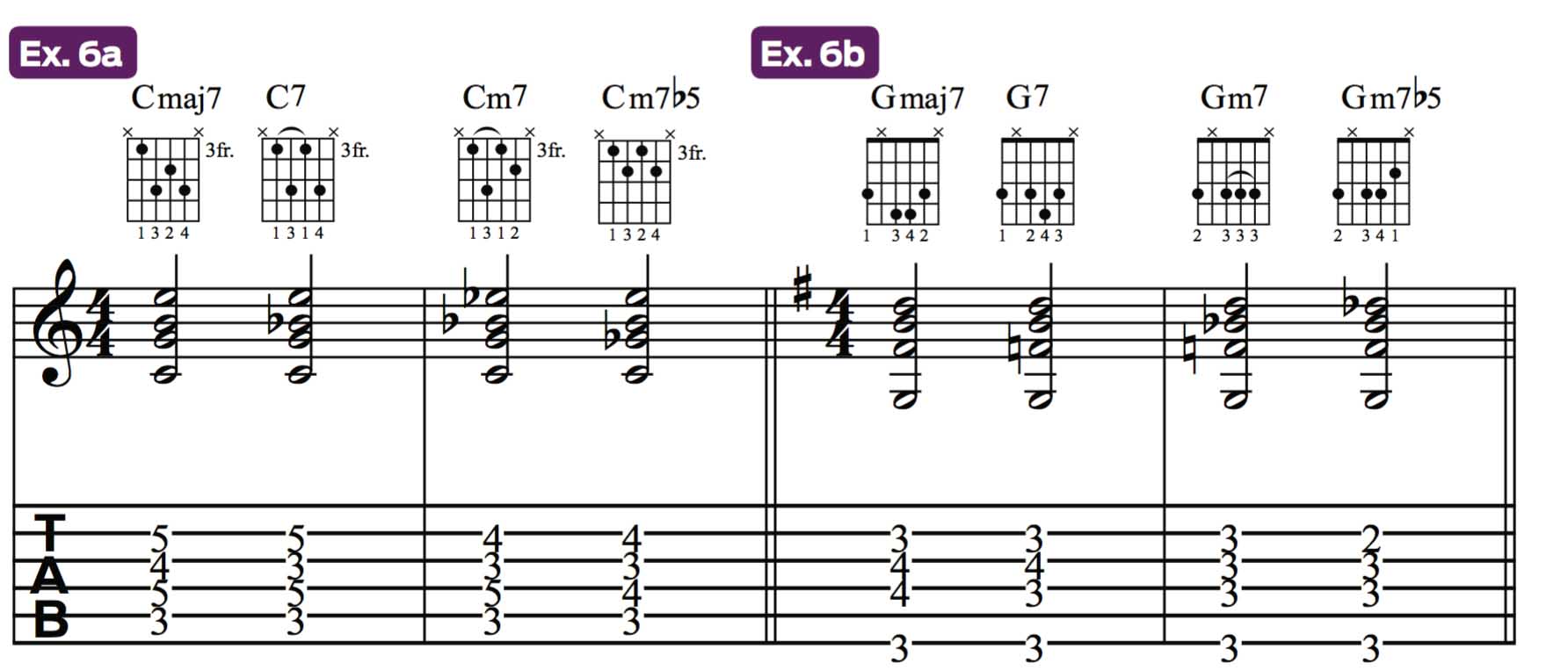
Aggressive players will oftentimes expand on these voicings by using tensions or inversions.Inversionsare voicings that rearrange the tones of a chord, moving the root so that it is no longer the lowest tone.
Ex. 7aexpands on the drop-2 voicings from Ex. 6a by presenting the four seventh-chord qualities (major 7, dominant 7, minor 7 and small-scale 7b5) in each of their inversions, moving upward the fretboard on the same grouping of strings.
We start with the root-position voicing of each chord, and from there each phonation will move up the aforementioned string to the next available chord tone, proceeding to beginning inversion (voiced, low to high: third - 7th - root - 5th), second inversion (fifth - root - 3rd - 7th) and finally third inversion (7th - 3rd - 5th - root).
Ex. 7btakes this same idea and applies information technology to the driblet-three voicings from Ex. 6b, starting from a G root on the sixth string.
Example 7a
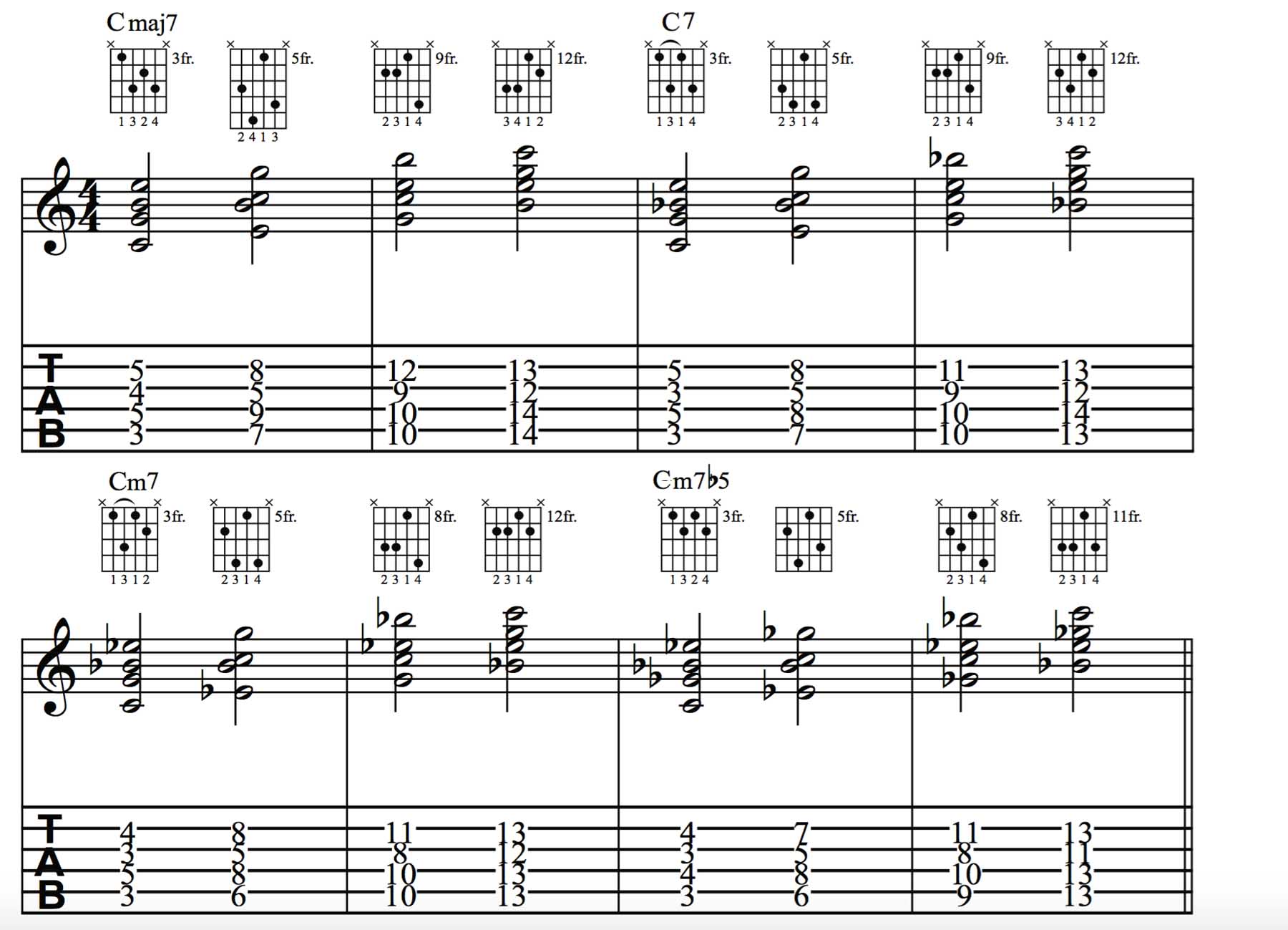
Example 7b
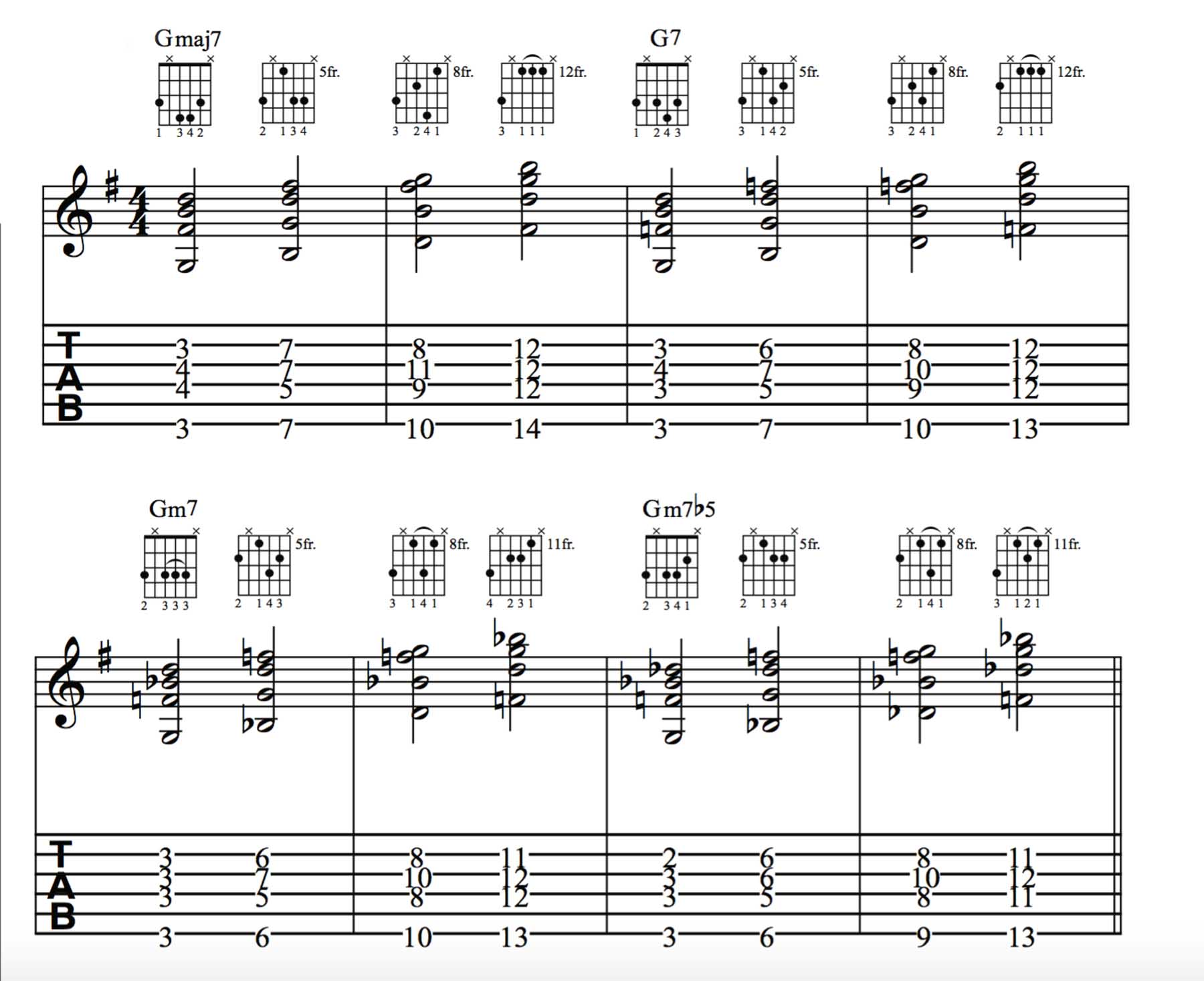
Ex. 8demonstrates how chord tensions may be used to add colour to a ii - V - I progression in the key of Ab (Bbm7 - Eb7 - Abmaj7). As you motion through the exercise you'll notice that the pick of tensions become increasingly more than complex.
At the commencement, tensions are purely diatonic to the key of Ab (Ab major scale: Ab, Bb, C, Db, Eb, F, G, Ab), but gradually, the tensions chosen arenondiatonic, or outside of the fundamental. The farther you venture out of the key, the more than tonally complex your voicings become, and then take intendance when choosing your tensions. More on that later.
Example 8
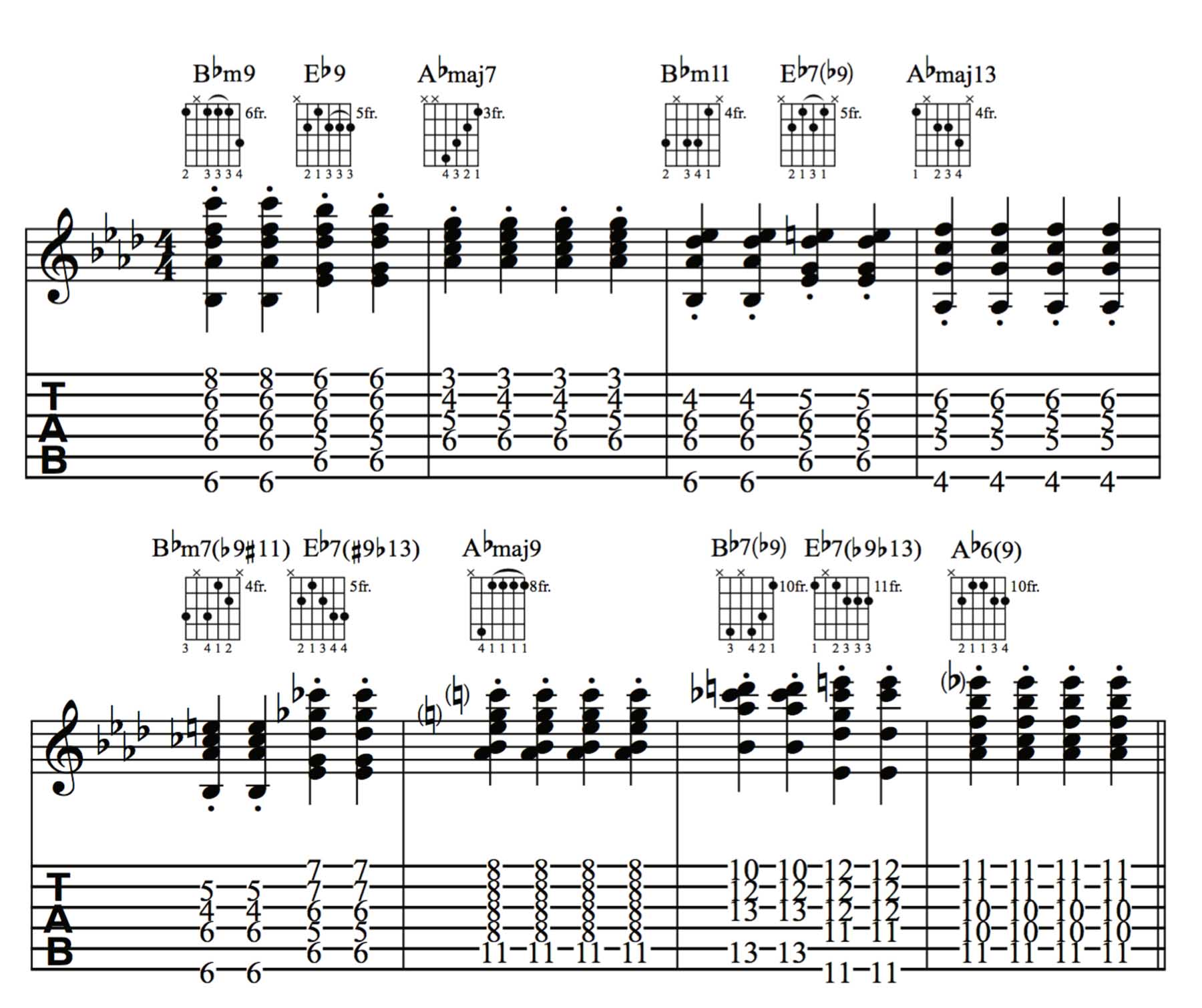
One special consideration to accept when choosing your voicing ishow muchof the chord to employ. It is often unnecessary to use all of the tones of a chord when comping. If you're playing with a bassist, for case, they'll typically play the roots of the chords, so you lot may opt to play rootless voicings.
If you're playing with a pianist or organ player, more expansive and dense voicings will likely disharmonism with what they are doing, then it'south likely best to only play the essential tones of each chord. The meg dollar question is "What is essential?" When whittling down your voicings, the beginning notes to remove are the root, then the 5th, unless it's flatted or sharped, leaving the 3rd and the seventh.
These tones are known asguide tones, and they exercise the about to convey the tonal quality of whatever chord.Ex. 9ais a ii - 5 - I - Six progression in the key of K (Am7 - D7 - Gmaj7 - E7) shown as an embellished guide-tone line. Note how the progression moves in a predominantly stepwise mode.
Example 9a
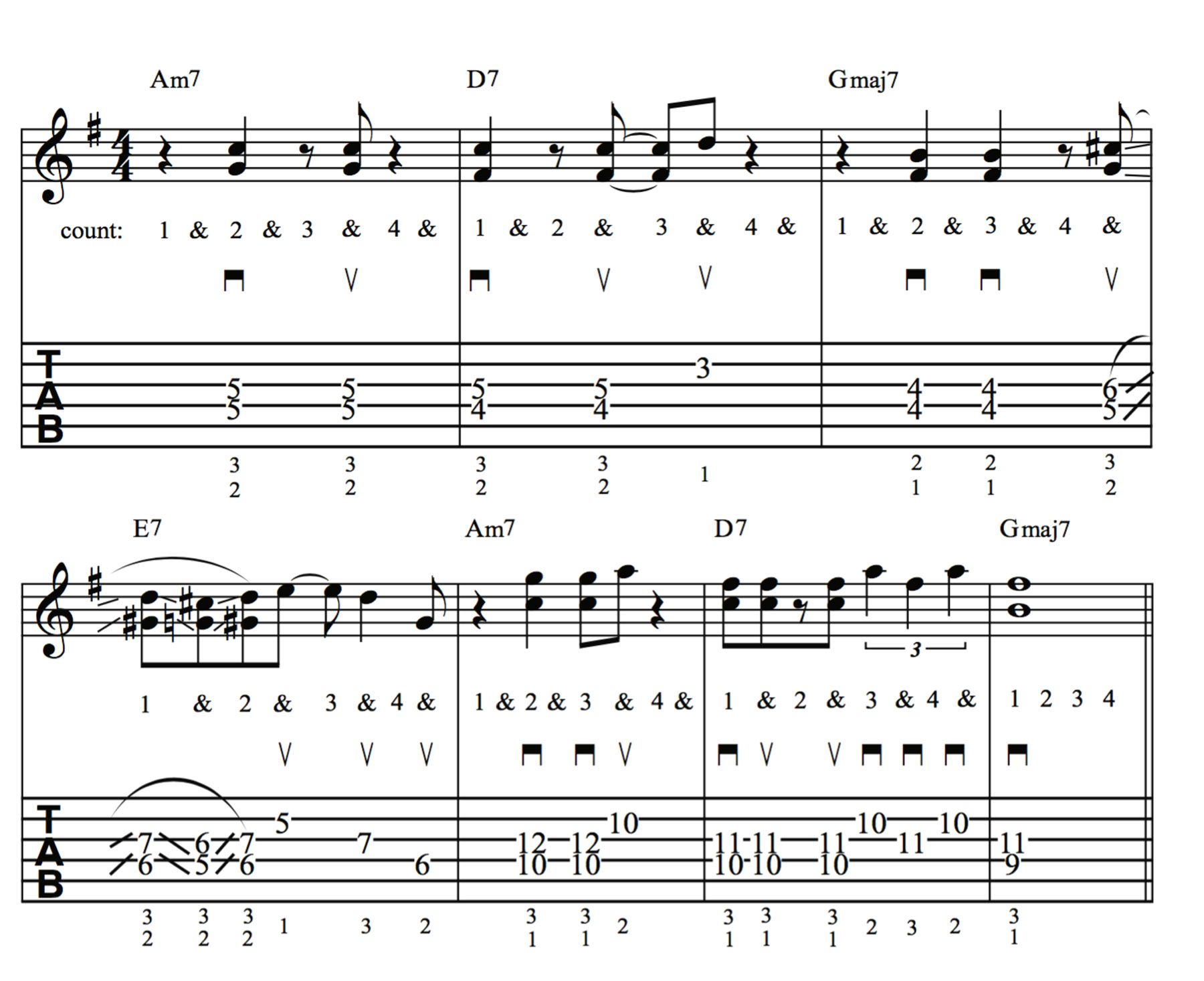
The benefit of using a guide-tone line when comping is that it highlights the harmonic motion of a progression in the simplest, most straightforward possible fashion while leaving ample sonic infinite for other musicians to fill.
Modern jazz guitarists, withal, volition often add together tensions to guide tones to continue their voicings compact without sacrificing tonal color or complexity.Ex. 9btakes the same progression and gives it a little actress tonal spice past calculation tensions to each voicing.
Example 9b
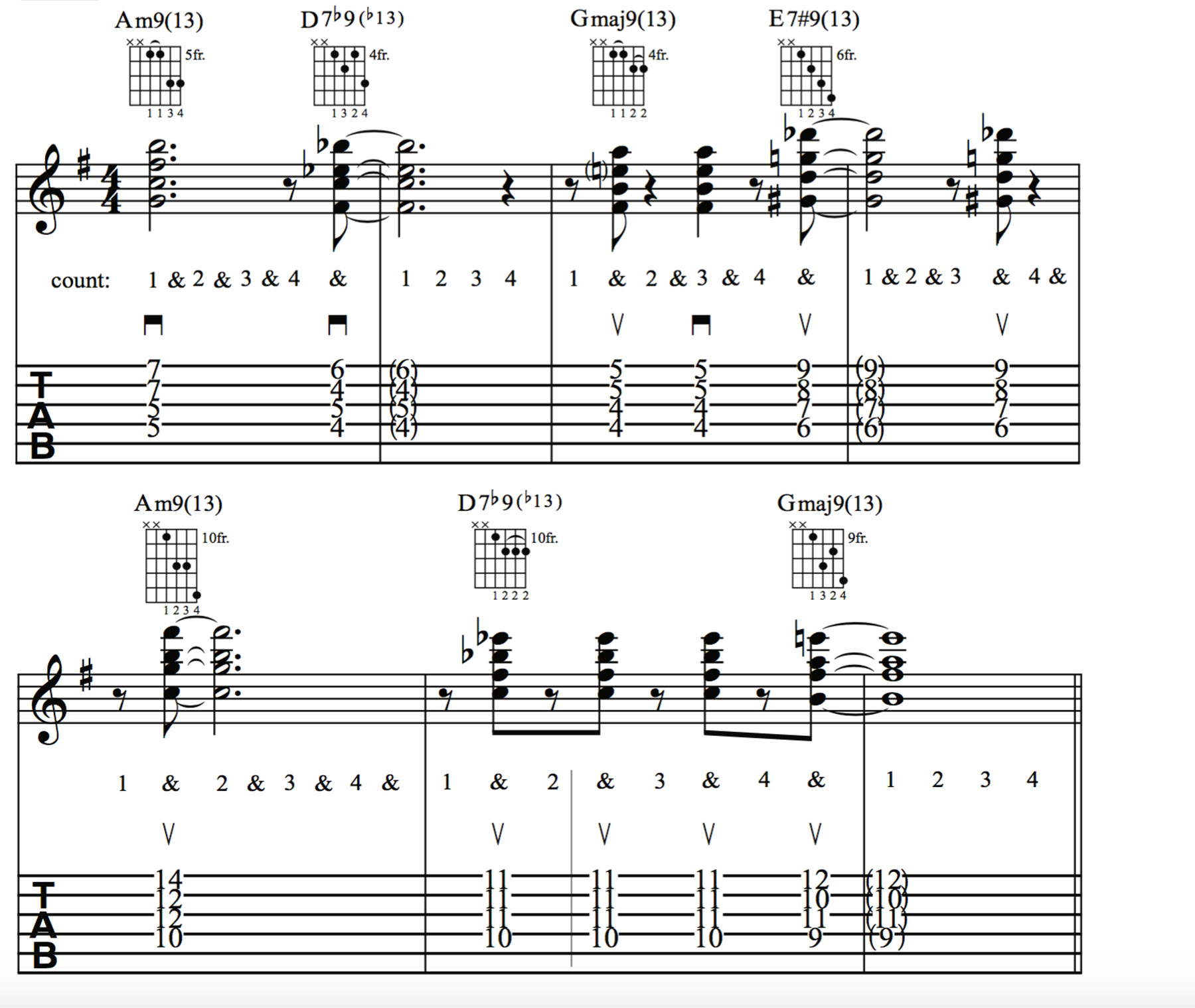
Truly audacious compers may eschew main chord tones almost entirely and opt for small-scale, tension-heavy voicings.Ex. 9cfocuses on voicings centered around variations of 9ths, 11ths and 13ths of each chord, clustering them together with chord tones for maximum harmonic dissonance.
This approach volition audio very "out at that place" on its ain, simply paired with the proper harmonic support it can audio extraordinarily dramatic and musical, so attempt it once you are fully comfy with comping and take the tonal space in the music to stretch out.
Instance 9c
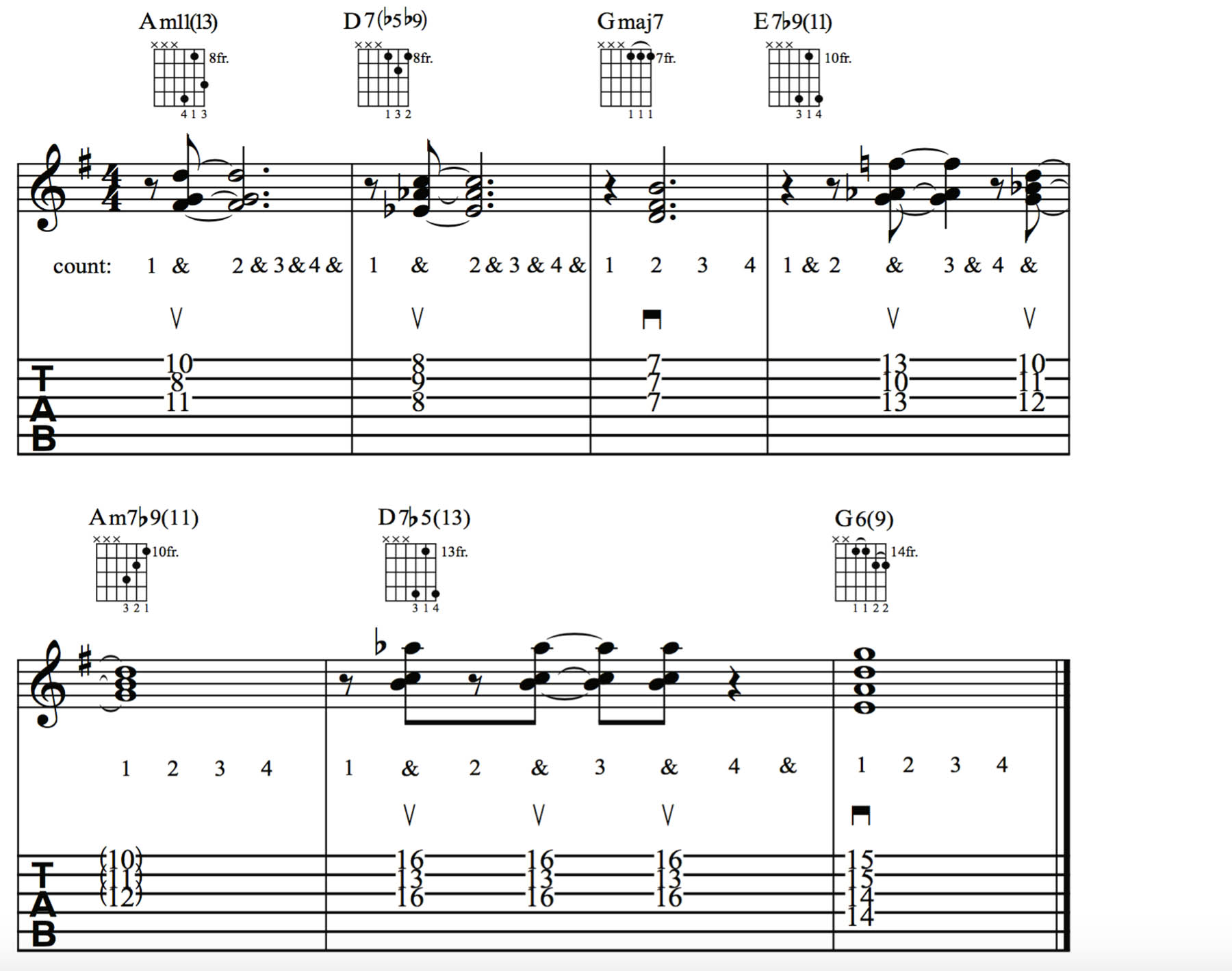
Other Considerations
Then how practice y'all know which approaches to apply? It all depends on the specific circumstances you find yourself playing in. A few factors that affect your comping approach include:
•The style of jazz.For big-band swing play fuller voicings, like drop-2s and 3s, Freddie Greenish Style. For Latin or Afro-Cuban jazz, endeavour syncopated rhythms like the clave. And for whatever sort of postal service-bop, modern jazz, information technology truly depends on the dynamic of the grouping you're playing with.
•Your band's instrumentation and dynamic.This is ane of the nigh crucial, nonetheless most overlooked factors governing one'due south approach to comping. The basic rule of pollex is that the more than accompaniment instruments there are in the ring - piano, organ, bass, drums, etc. - thelessyou demand to play.
This can inform your option of voicings and/or rhythmic phrasing. If, for case, you're jamming with a piano role player who plays flowing Beak Evans-style polychords, the ideal approach would be smaller, college-pitched voicings played sparsely, so as to get out room for the massive piano chords.
If, however, the pianist is playing sparsely, with smaller voicings and short choppy rhythms, you can play more densely voiced chords in a more consistent rhythm.
•The melody and the soloist.This is the most important consideration - the cistron that determineseverything. The melody, or the choices made by the soloist, dictates the kinds of voicings you lot can apply, what tensions are available to you and your rhythmic options.
In essence, you are playing an interactive game of "follow the soloist." If they starting time playing a recurring rhythmic motif, latch onto information technology. If they're playing breathlessly fast bebop passages replete with tensions galore; brand sure you leave space in the rhythm for them, either utilizing long-held chords or lots of extended rests, but go nuts when it comes to your voicings! If you're playing a ballad with a flowing, melancholy melody; it'due south best to match it with long, flowing chords and, if you lot like, to use any tensions that the melody indicates.
The key is to accommodate your playing to the feel of the song and the players around you. This lesson only begins to scratch the surface of all the possibilities, but now you have the know-how to work out your own comping ideas and venture into any jazz session with confidence.
Performance Tips
i.All examples in this lesson may exist played with aswing-eighths feel(usually referred to simply as a swing feel). Swing-eighths is based on an undercurrent of eighth-note triplets, every bit you would have in 12/viii meter, with the first eighth notation of each beat held for what would be the first 2 eighth notes of an eighth-notation triplet and the second eighth note (on the upbeat) played on what would exist the tertiary annotation of the triplet.
This results in a lopsided-sounding "long-short" rhythm for each pair of eighth notes. (Recall the shuffle feel heard in "Pride and Joy" by Stevie Ray Vaughan and the blues standard "Sweet Domicile Chicago.") Alternatively, you could play any of the examples with what'southward chosen aneven eighths, orstraight eighths, feel, which would piece of work beautifully with a Latin groove, such equally the bossa nova beat, which is quite common in jazz.
ii.You'll notice that we've included choice strokes in some of the examples, with the indication that whatever chord that falls on an eighth-notation upbeat is to be strummed with an upstroke. To best feel the rhythm and the desired groove, y'all'll want to go along your choice hand moving back and along beyond the strings in a continuously alternating and unbroken downwards-up-down-up pattern, with no pausing, or "freezing," during the rests.
This technique, oftentimes referred to every bit8th-note pendulum strumming, keeps the mitt in perpetual motion, with silent, "phantom" downstrokes and/or upstrokes used betwixt strums (but non notated or heard) for the sake of keeping the hand moving back and along across the strings in a flowing mode.
Another useful technique and alternative selection-hand approach is to not strum the strings at all, but rather pluck the notes of each chord simultaneously, using either hybrid picking (pick-and-fingers technique), or direct fingerpicking, which works all-time for five-note voicings. This plucking technique gives you a simultaneous, non-staggered note assail, alike to the way a piano player or organist would comp.
washingtoncalwascame87.blogspot.com
Source: https://www.guitarplayer.com/lessons/learn-jazz-compings-techniques-chord-voicings-and-rhythms
Post a Comment for "We ll Be Together Again Jazz Guitar Lesson"